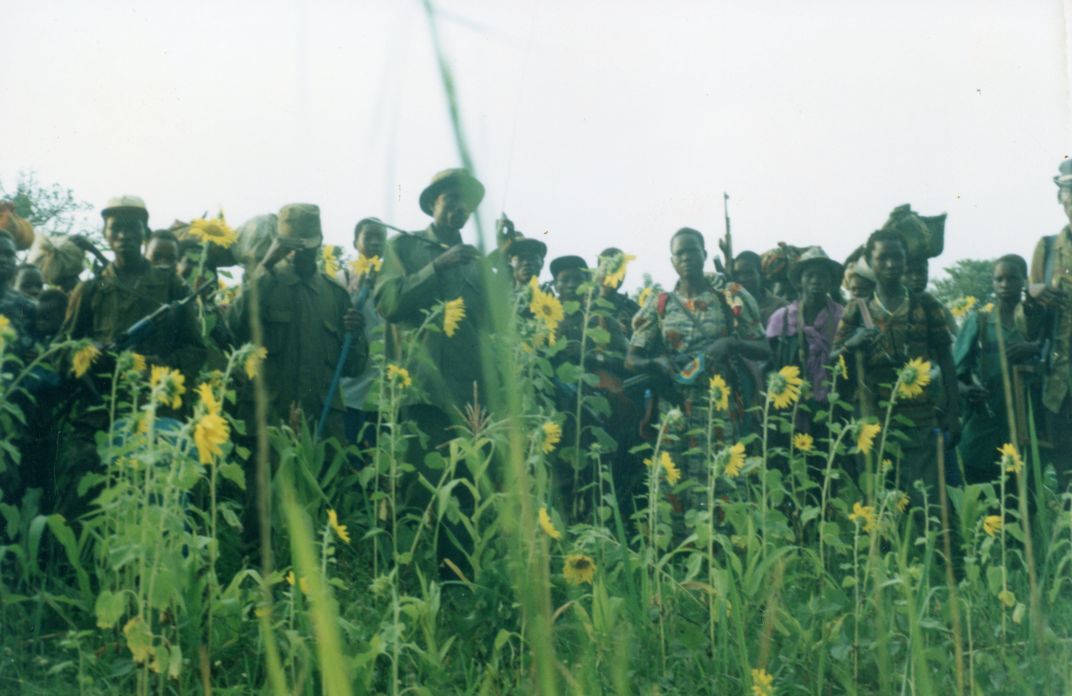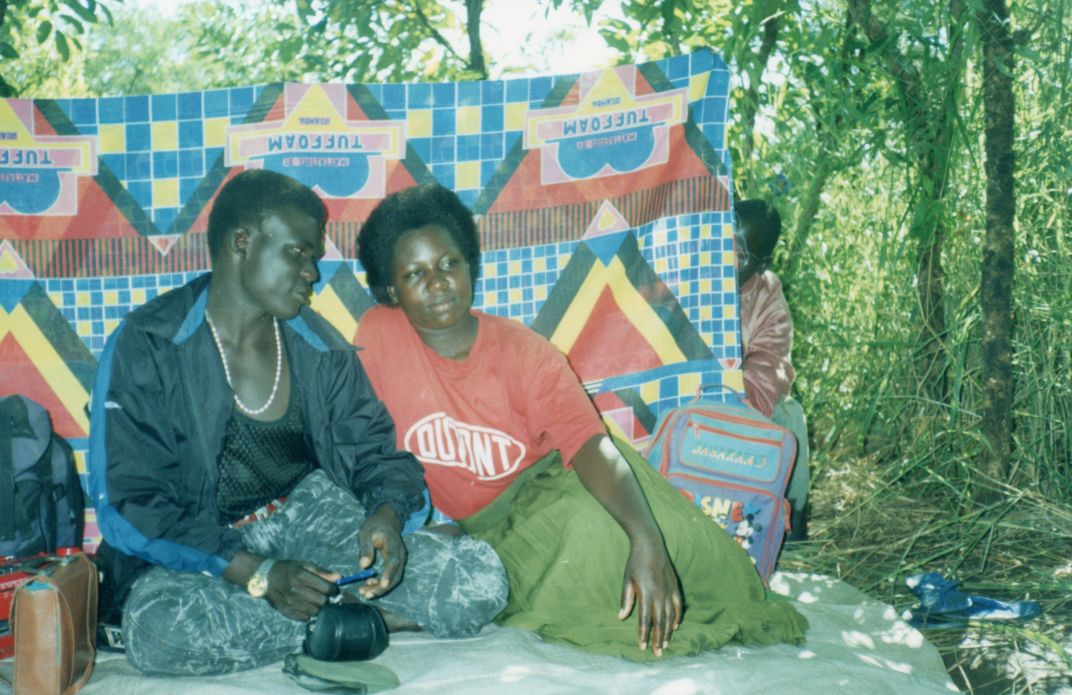How a Notorious Ugandan Rebel Group Used Everyday Snapshots as Propaganda
A new exhibition explores the underlying agenda of seemingly mundane photographs taken by members of the Lord’s Resistance Army
:focal(3082x1220:3083x1221)/https://tf-cmsv2-smithsonianmag-media.s3.amazonaws.com/filer/c8/06/c8068fbf-8f00-4bbb-81f9-9c6e9655559a/img277.jpg)
Posing in their colored dresses and patterned skirts, six young Ugandan women stare intently at the camera as the photographer snaps their picture. They look like familiar friends, casually spending time together while dressed in their Sunday best.
To an outsider seeing the photograph, the scene exudes normalcy. Nothing about its subjects’ clothes, stance or setup appears unsettling. But when examined within its true context, the image reveals a disturbing truth: These women are “rebel wives,” kidnapped at a young age and forced to live among dangerous criminals—the Lord’s Resistance Army, or LRA—known for their extreme violence and large-scale abductions of children.
One of many included in Kristof Titeca’s Rebel Lives: Photographs From Inside the Lord’s Resistance Army, a new monograph published in conjunction with an exhibition on view at the United Nations’ New York headquarters, the snapshot is part of a series that explores how seemingly quotidian scenes were manufactured to reflect how the notorious Ugandan militia group wanted to be seen.
“The photos have a profound ambiguity,” writes Titeca for the Conversation. “They illustrate the tension between extreme violence and the everyday lives of the rebels. They show abducted young men and women who have been exposed to large degrees of violence—and who have been committing these acts themselves. At the same time, they also show how, within this context of extreme violence, life continues to be surprisingly ordinary.”

When placed in the correct context, these photographs reveal information about the underlying goals and intentions of the rebel group. According to Titeca, photography was used as a means to showcase the group’s power and incite fear, but also to oppose its negative international image.
As Arno Haijtema explains for Flemish newspaper DeMorgen, the photographs strive to emphasize the “ordinary” nature of life within the LRA, sending an implicit—and fabricated—message that despite the bloodshed occurring off-camera, militia members are just like everyone else.
In many of the photographs, the rebels are seen carrying guns, knives and other weapons in an attempt to show off their military power. Such arsenals were often left near army bases in order to sow terror among the LRA’s enemies.
Other images, like that of the women in the dresses, or of children with their mothers, look like they could have been pulled from a family photo album. They depict memories of everyday life, reminding the viewer that some of these fighters are ordinary people who didn’t join the group freely.
“Abductees had to cut all ties with their families, often in the most brutal ways, and instead had to consider the LRA as their home and family,” explains Titeca in Rebel Lives. “The photographs were part of this process: [T]hey helped to enact and portray the idea of the LRA as their family.”
In an article for the Washington Post, Titeca, an expert in development policy, notes that while news of the movement has been widespread, knowledge of what life within the rebel movement actually looks like is limited.
“I collected hundreds of photos over many years in Northern Uganda, making copies from those held by former rebels, peace activists and journalists,” he writes. “Over two years, I also located the former rebels in the photographs, both to ask their permission to use the photographs and to understand the photographs’ meanings and uses.”
Part insurgency and part cult, the LRA emerged from the remnants of priestess Alice Lakwena’s rebellious Holy Spirit Movement in the late 1980s. Following Lakwena’s exile, a group led by Joseph Kony gained power and adopted the name by which it is known today. While the LRA was initially formed in opposition to the Ugandan regime, in the decades since its creation, it has turned against civilians, spreading terror across the region.
“[The LRA] raids villages, massacres for no other purpose than bloodlust, enslaves child soldiers and child sex slaves,” wrote Max Fisher for the Atlantic in 2011, “[…] all in an apparently endless mission that has destroyed countless villages and killed thousands of civilians, transforming one of the world’s least governed spaces into one of its most dangerous.”
The leader of this militia, Kony, captured global attention after the Kony 2012 campaign, led by the organization Invisible Children, produced a viral video detailing the rebel group’s misdeeds. Now a globally known war criminal, Kony remains at large, not yet held accountable for the LRA’s abduction of more than 67,000 youth since its inception, nor the violent actions perpetuated by him and his followers.

Following successful campaigns by the United States and Uganda, the movement has shrunk significantly in size. As Jason Burke and Alon Mwesigwa reported for the Guardian in 2017, “Kony and the LRA are a shadow of the threat they were [ten] or even 20 years ago.”
The rebels who remain, however, are still inciting violence in the lands between the Central African Republic, the Democratic Republic of Congo and South Sudan.
The exhibition currently on view uses photography and research conducted by Titeca to explore life within the LRA and the experiences of ex-rebels since leaving. Per the UN website, the photographs reflect the ambiguous line between LRA victims and perpetrators, exploring how these categories overlap and how children are often the true victims of the tension.
In the preface for the book, journalist and filmmaker Jonathan Littell describes the embedded meanings images such as these uncover.
“The photographs presented in this book may have many other meanings, political, ideological, historical, and documentary,” explains Littell. “[…] But they also carry, inscribed in their grainy texture, this simple lesson about the nature of childhoods drowned in war.”
“Rebel Lives: Photographs From Inside the Lord’s Resistance Army” is on view at the United Nations’ Manhattan headquarters through February 18, 2020.
/https://tf-cmsv2-smithsonianmag-media.s3.amazonaws.com/accounts/headshot/Image_from_iOS.jpg)
/https://tf-cmsv2-smithsonianmag-media.s3.amazonaws.com/accounts/headshot/Image_from_iOS.jpg)